Organic Chemistry - Test #3
1/48
There's no tags or description
Looks like no tags are added yet.
Name | Mastery | Learn | Test | Matching | Spaced |
|---|
No study sessions yet.
49 Terms
Thermodynamic Favorability
Thermodynamics: The most stable product will be formed in a favored reaction
Favored reactions release energy
Exothermic: reactions that release heat vs. Endothermic: reactions that require heat (enthalpy H)
Exergonic: release energy vs. Endergonic: reactions that require energy (free energy G)
To assess which direction a reaction is thermodynamically favored: compare the stability of both sides (focus on the most unstable compound on each side... Charges!)
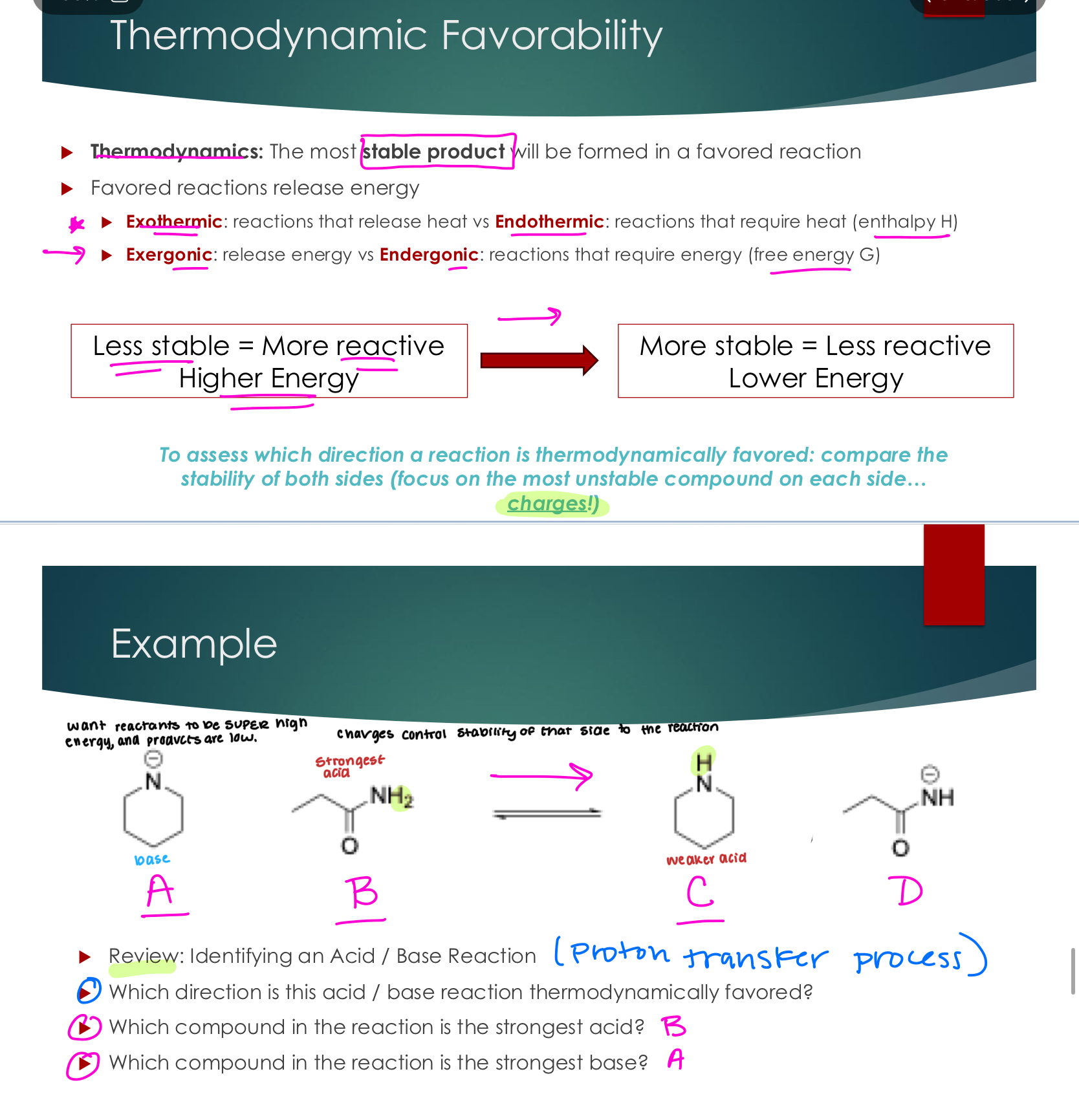
Kinetic Favorability
Kinetics: What will happen fastest?
The more unstable the reactant the faster it will react
The easier the transition state is to access, the faster it will react
FAST DOES NOT EQUAL FAVORABLE
To assess which reaction will occur faster: compare the reactivities of the reactants or the activation energies / energy of the transition states
General Principle: Reactions that only involve the transfer of a single proton (Acid/Basen Reactions) are kinetically very fast!
> Practical Take Away: if an Acid/Base is possible, it will happen first.
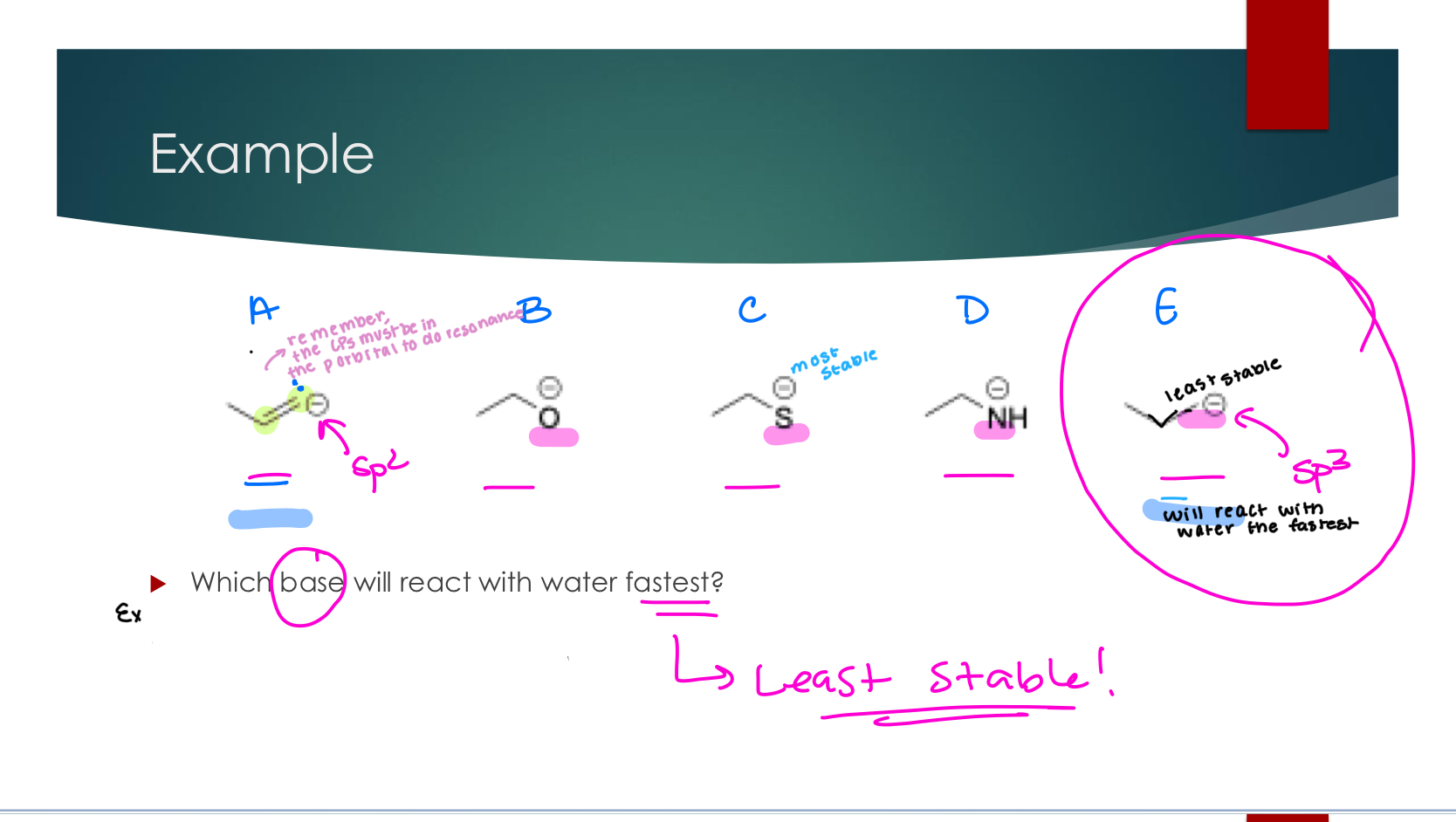
Collision Theory & Molecularity
Molecules have to physically collide with each other in order to react, so the things that affect how quickly product can be made are:
Number of collisions = possession time: if one team has the puck 90 % of the time, you’d guess that they’re have a higher score.
Required Orientation of Collisions = shots on goal, you need the right shot to score, you can shoot all you want but it needs to go in.
Required Energy of Collisions (Activation Energy or Ea) = Goalie: low activation energy it’s a bad goalie, and you’re going to get more goals. High activation energy and it’s a good goalie, and you’re going to get less goals.
Statistics: How probable for molecules to collide → Reaction Molecularity
Unimolecular: The reaction happens within the same molecule, requires no collisions with another molecule
Bimolecular: The reaction requires two molecules colliding
Termolecular: The reaction requires three molecules colliding
Mechanisms & Elementary Steps
Reactions typically occur in a series of elementary steps : description of what molecules collide to lead to a product
Typically unimolecular or bimolecular
Overall reaction: Summary of all reactants & final products
A reaction mechanism is the order of elementary steps that must occur to generate the final product
Intermediates: chemical compounds produced in one elementary step and used in another elementary step, these compounds only appear in a mechanism, not an overall reaction
Mechanisms are just a guess of how things happen, and they’re ot factual this is how this happens.
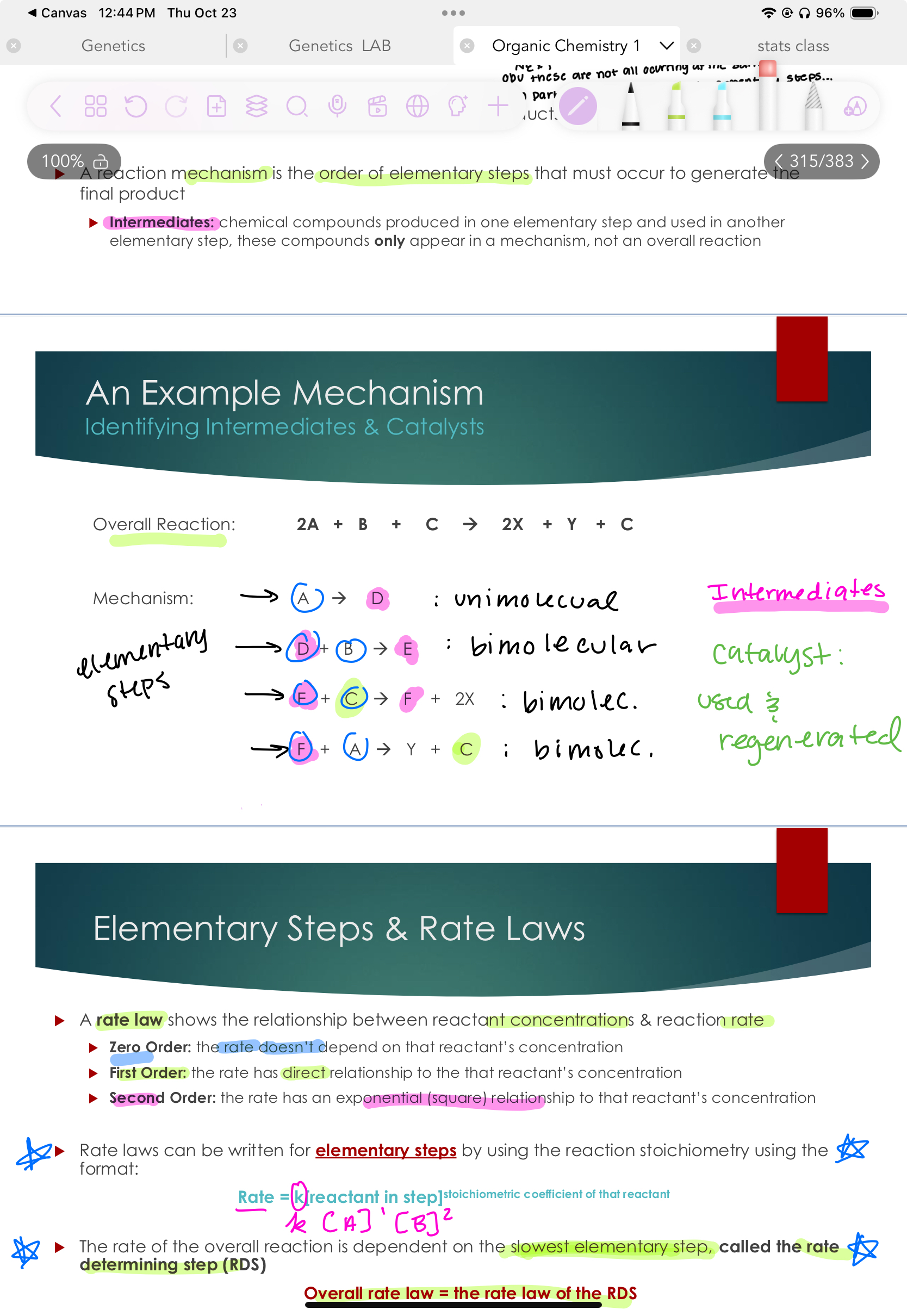
Elementary Steps & Rate Laws
A rate law shows the relationship between reactant concentrations & reaction rate
Zero Order: the rate doesn’t depend on that reactant’s concentration
First Order: the rate has direct relationship to the that reactant’s concentration
Second Order: the rate has an exponential (square) relationship to that reactant’s concentration
Rate laws can be written for elementary steps by using the reaction stoichiometry using the format:
Rate = k[reactant in step]stoichiometric coefficient of that reactant
The rate of the overall reaction is dependent on the slowest elementary step, called the rate determining step (RDS)
Overall rate law = the rate law of the RDS
Representing the Mechanism Graphically
Interpreting & Labeling Reaction Coordinate Diagrams
The number of peaks is the number of elementary steps
The peak is the transition state
The highest peak represents the rate-determining step
Energy levels can be determined
Exothermic → PDS are lower in energy
Endothermic → Products are higher in energy
Kinetic Activation energy is the energy difference between the reactants and products.
What is the maximum increase in energy I need to make products.
Thermodynamics ∆H/∆G: energy difference between reactants and products.
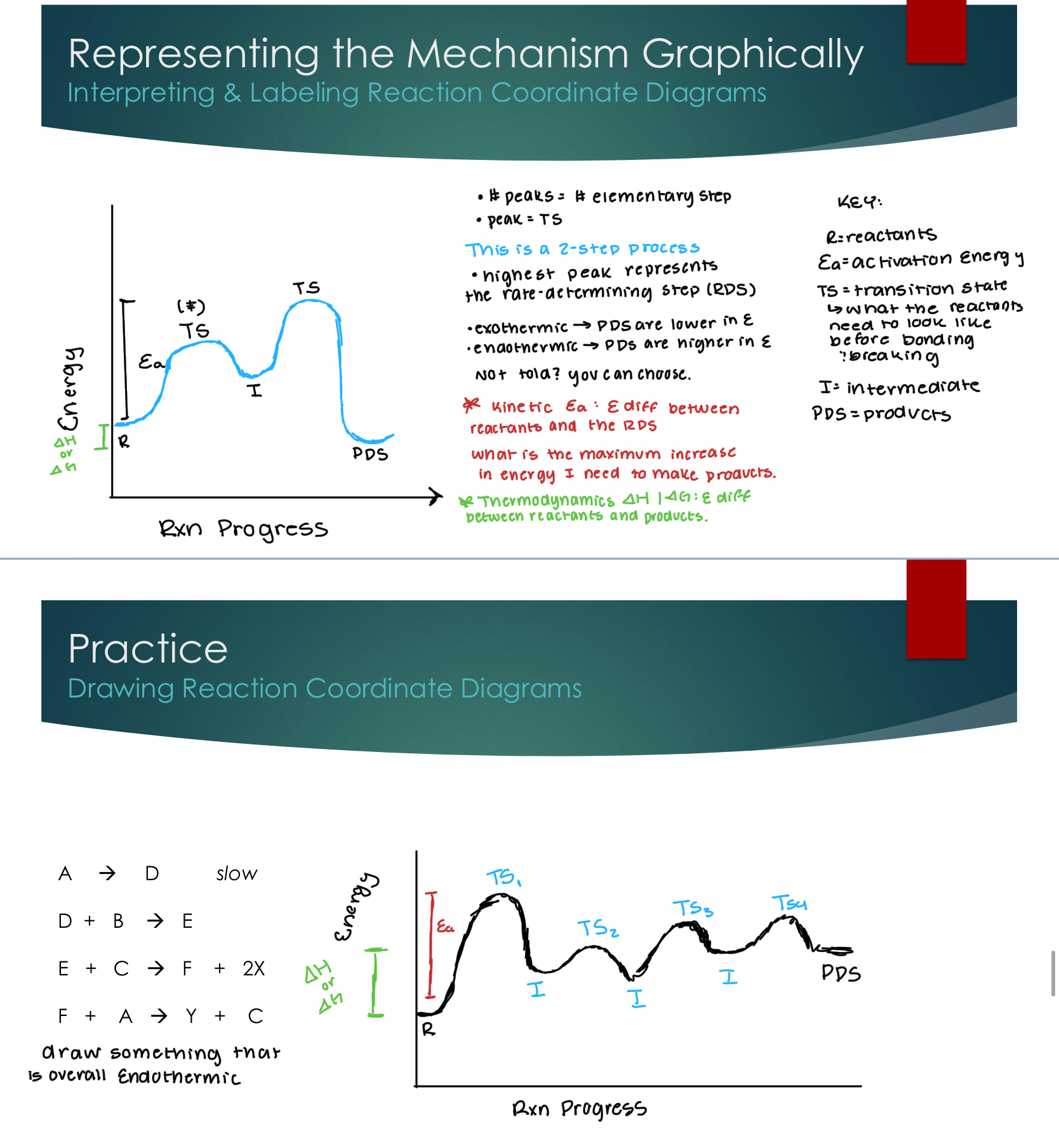
Major & Minor Products
Some reactions can lead to multiple products
Major product(s): the product(s) that is/are formed in greatest quantity (whatever you make more of)
Minor product(s): the product(s) that is/are formed in lesser quantity
When there’s one product, there’s only one major and no minor
Major products are typically:
More stable (thermodynamics control the products)
Formed by the fastest mechanistic option (kinetics control the products)
Nucleophilic Substitution Reactions
Can’t say it’s bimolecular or anything because we don’t have the elementary steps.
KEY FEATURES:
SP3 Carbon is connected to a good Leaving Group. N
Nucleophile as our reacting partner
They will switch places in the products…
Typically, very stable ions serve as a counter ion… it will have the opposite charge of whatever our species had. To recognize them, we need to be able to identify ions.
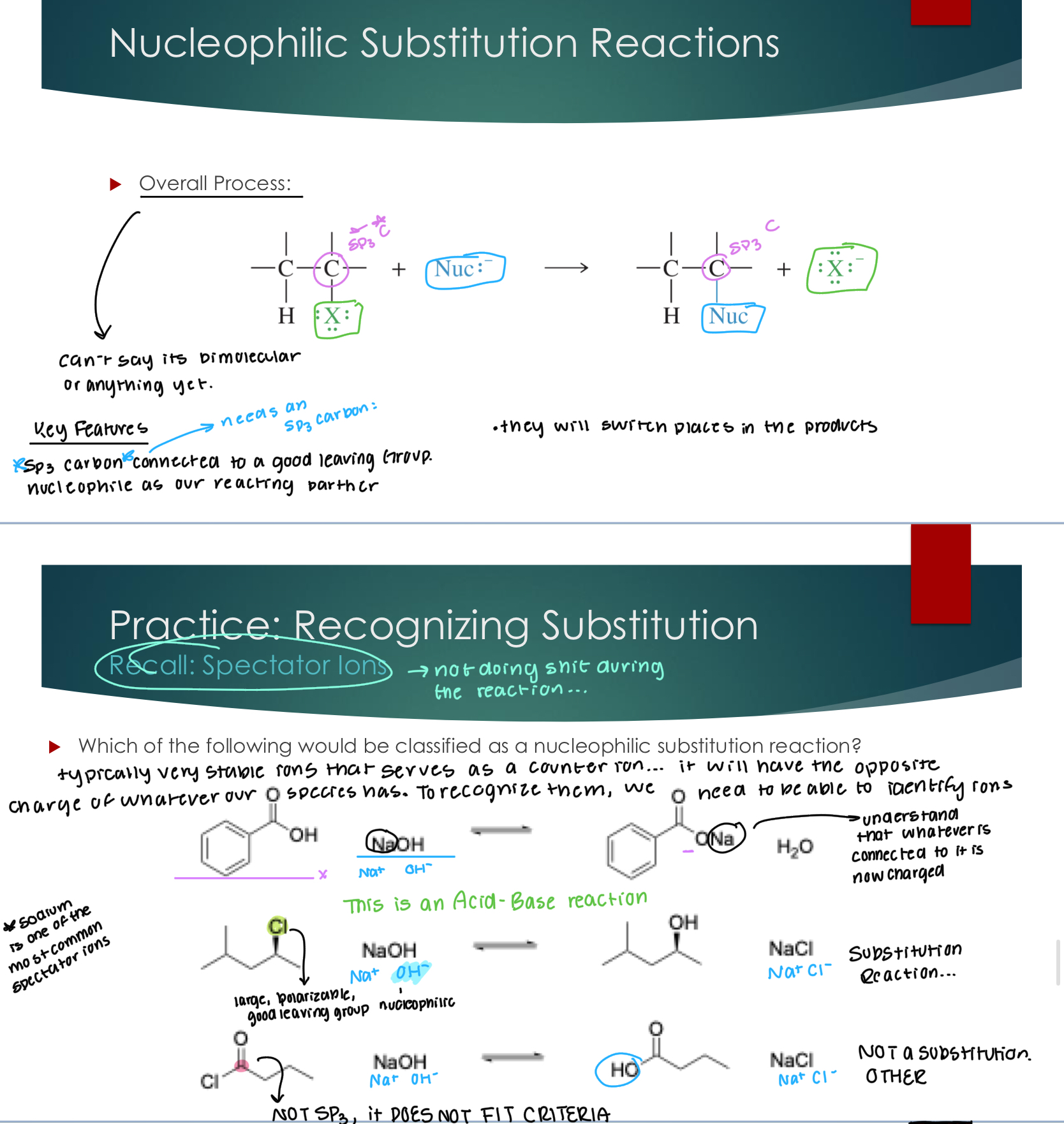
The Sn2 Mechanism: The first mechanistic possibility for substitution
KEY FEATURES
Only one step
Only one transition state
Concerted: bonds forming and breaking at the same time
Two things are colliding in the same step: bimolecular
RDS is our only step.
When can this happen? What will the collision look like?
Orientation must be correct: 108° orientation where nucleophile is attacking and leaving group is leaving.
Nucleophile must do backside attack to generate a transition state
Pentavalent: 5 things around carbon
smaller groups easier to put around C, which leads to a better reaction.
We have to thing about pentavalent rules to see if this is eligible to happen.
Want to overlap for the backside attack to maintain the 180° orientation (look at orbital diagram if you don’t understand why).
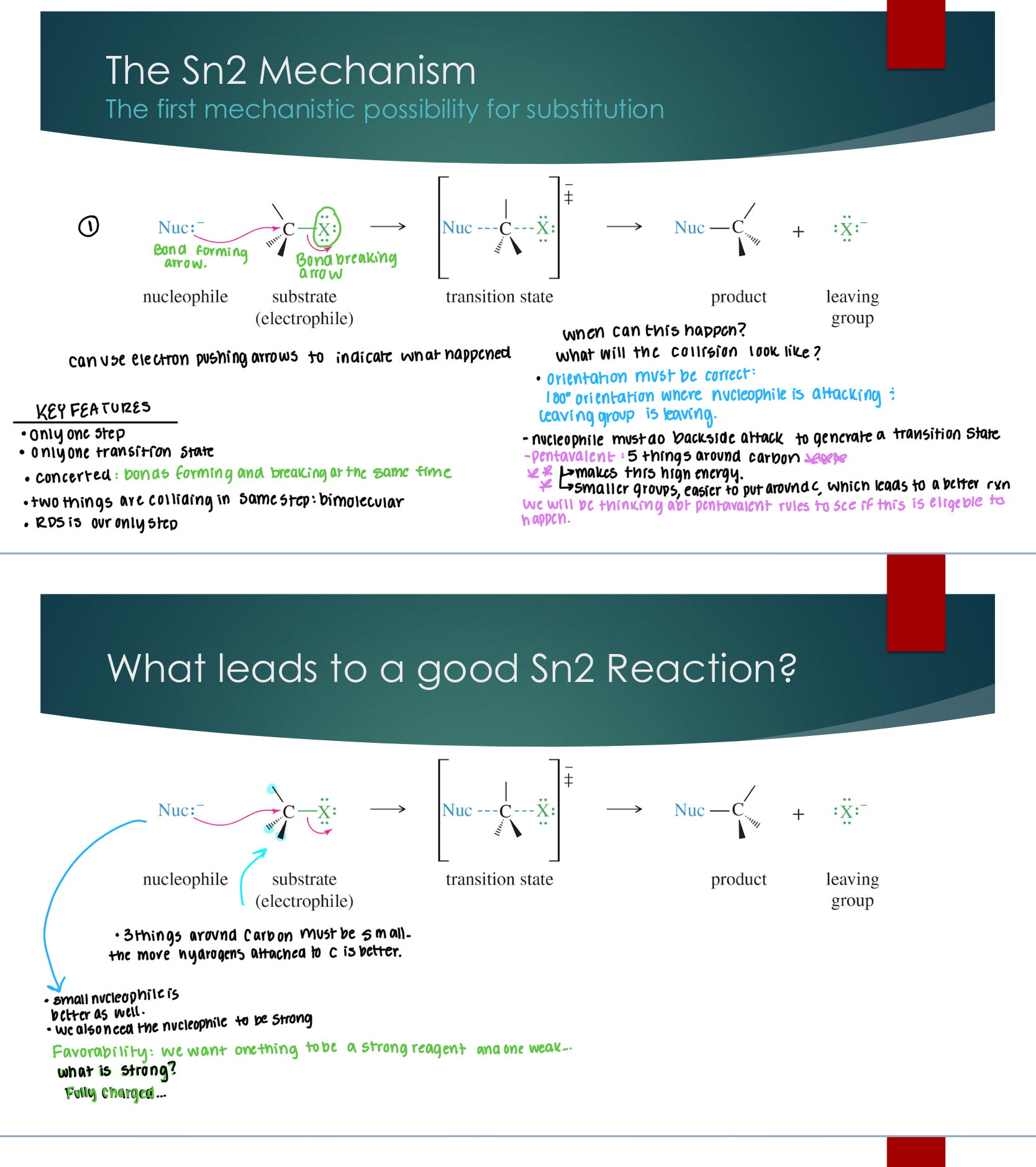
Reaction Coordinate Diagram and Rate law for SN2
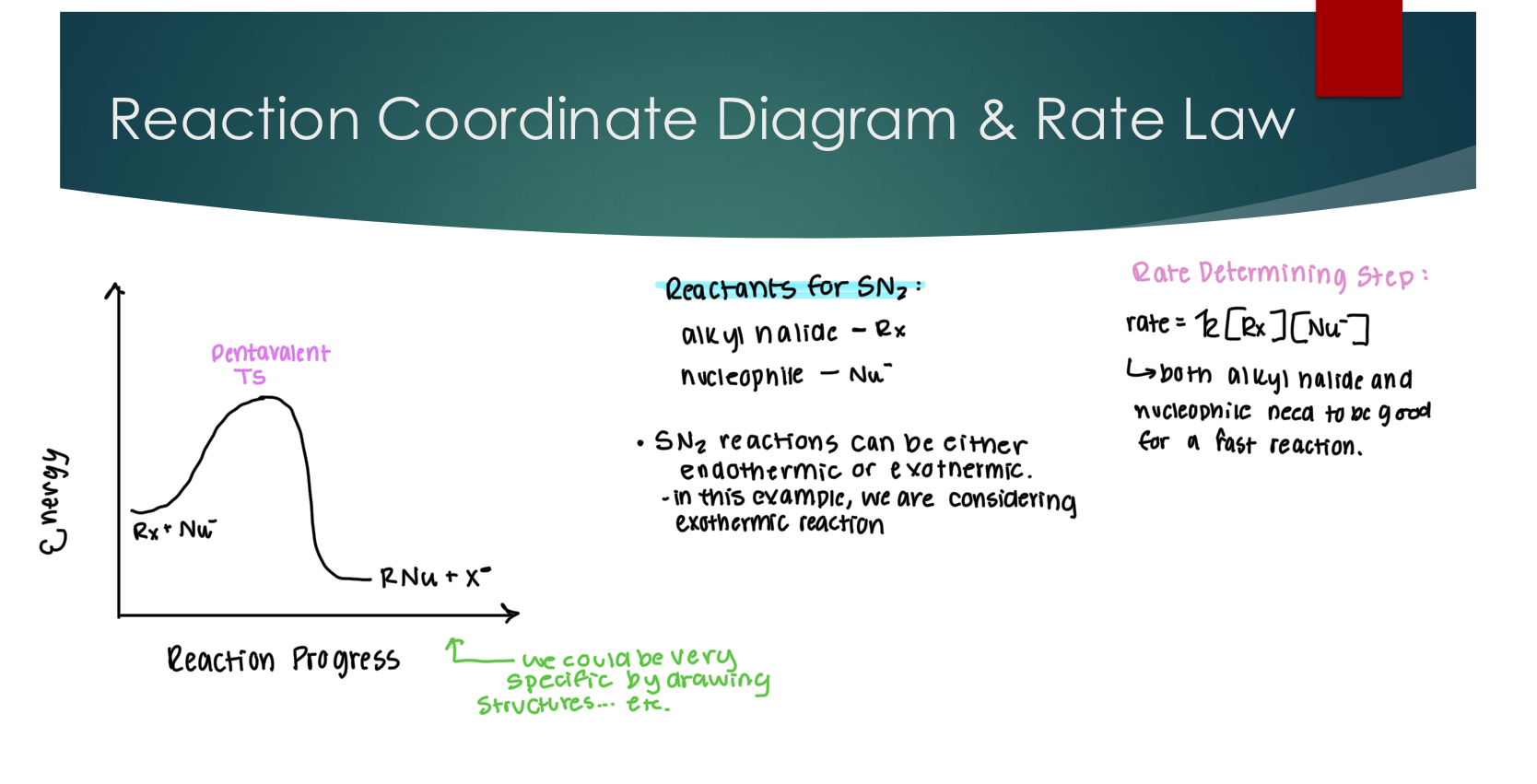
Stereochemistry & Sn2
Stereocenters in the products have inversions, where R would go to S and S would go to R. Note, it’s only the product and specifically the stereocenter affected that has the inversion, not the other stereocenters within the molecule.
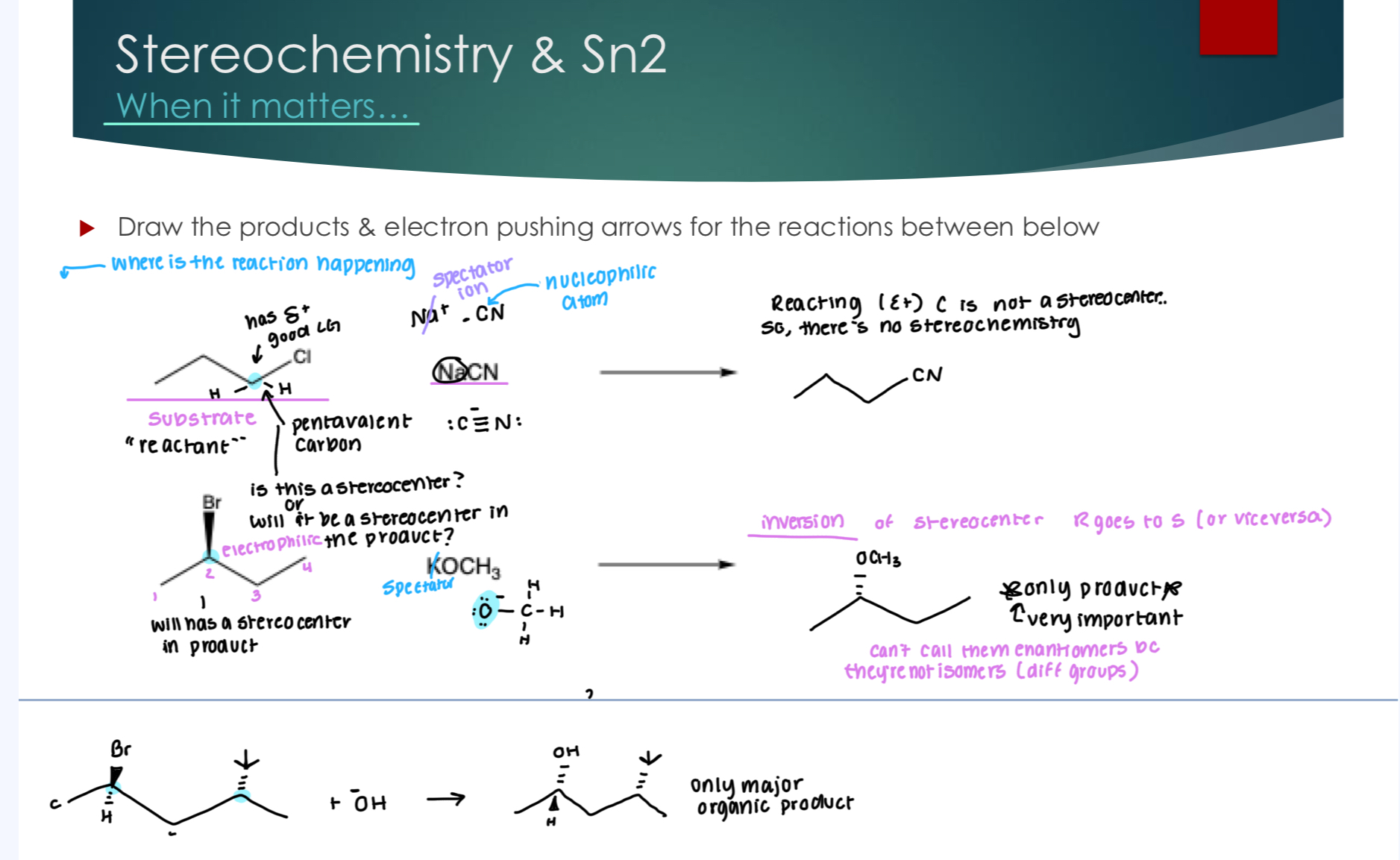
Good Nucleophiles for Sn2
Want something that isn’t bulky!! Long chains of carbon are NOT bulky: there are general rules (like primary, secondary, and tertiary) as seen by the chart, but you don’t want bulkiness because then the nucleophile can’t reach the halogen to be able to do the backside attack.
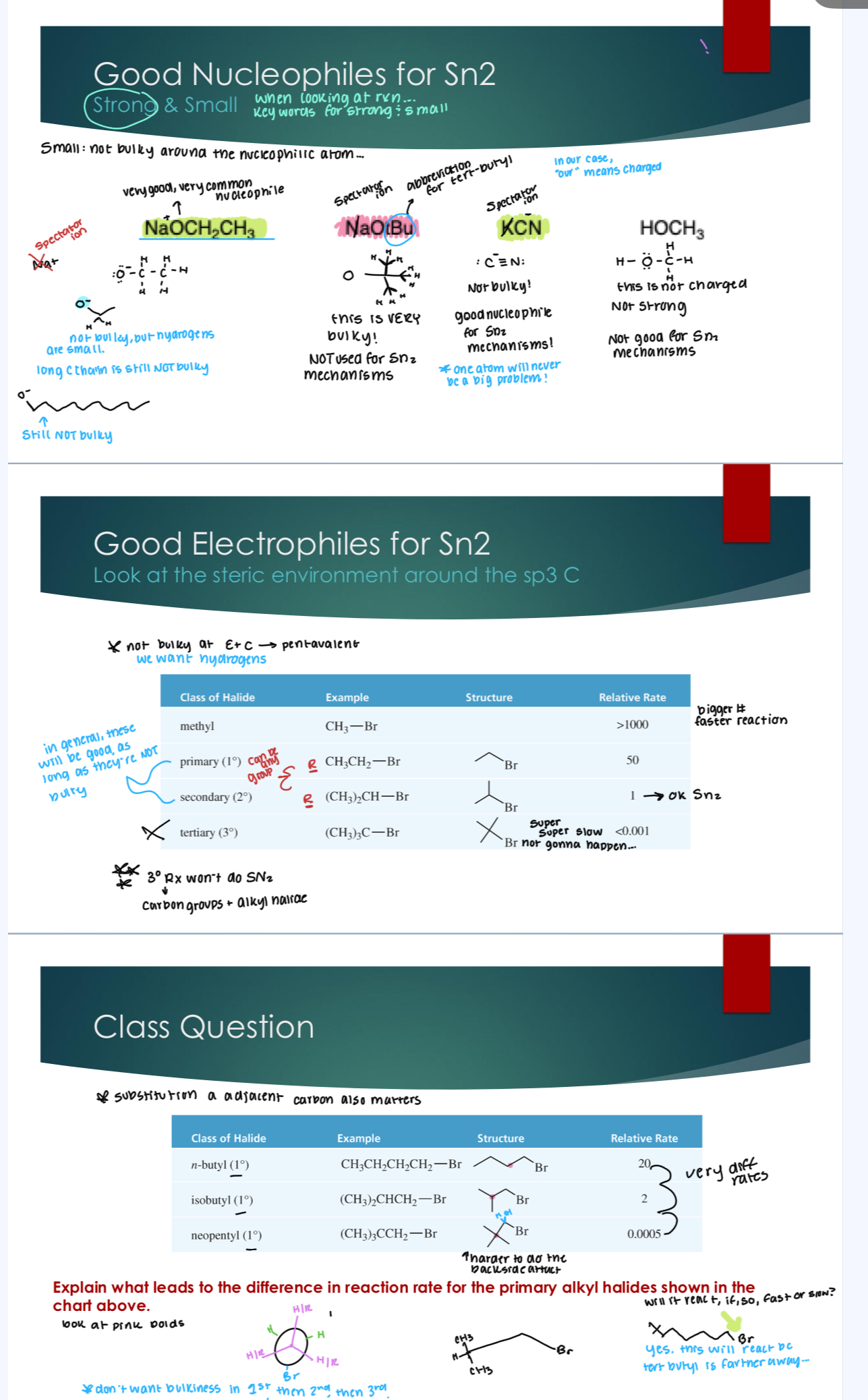
Solvent effects in Sn2
protic solvent: is when there is at least on H-bond donor.
aprotic solvent: when there is a solvent with no H-bond donors.
protic is solvated (surrounded by solvent) which makes it bulkier and harder to react. Charged compounds get solvated in protic solvent so we want aprotic solvents but NOT aprotic solvents.
An Sn2 reaction is still possible in a protic solvent, it will just be slower
➢ Solvent effects are the last priority when considering how “good” an Sn2 reaction will be, and in determining if a different mechanism will proceed instead.
➢ In general, the solvent will not be the only reason a reaction will not go through a Sn2 mechanism
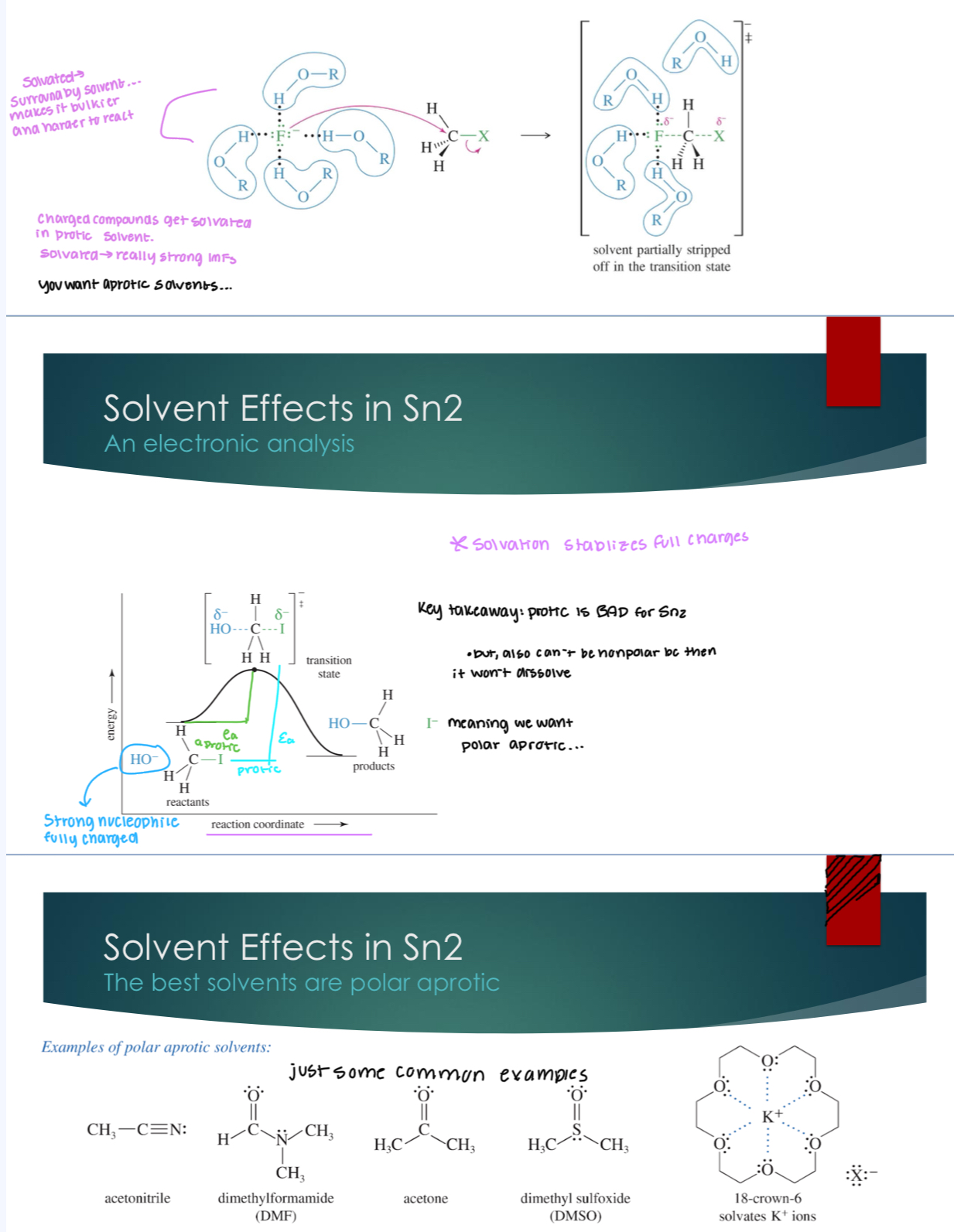
Sn2 Summary
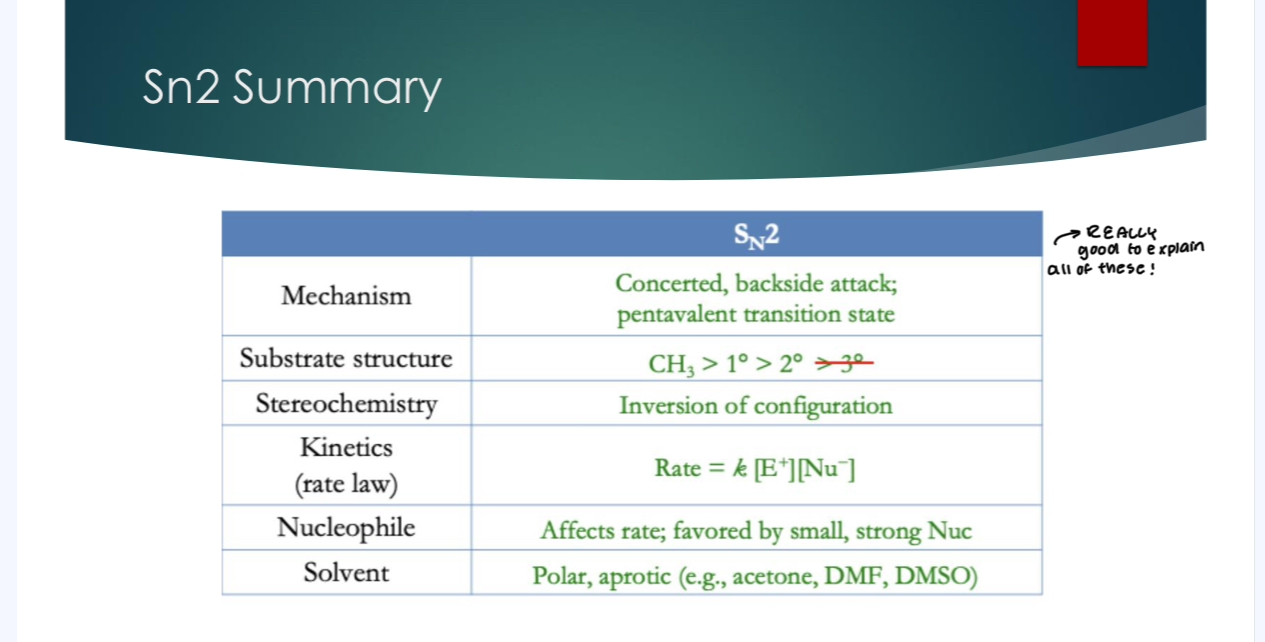
The Sn 1 mechanism
*When we use something as a solvent, we have a shit ton of that particular quantity. For Sn1 mechanisms, the thing we’re reacting with is the solvent.
Step 1: Formation of the carbocation (unimolecular)
Step 2: Nucleophilic attack on the carbocation
Final step: loss of proton to solvent, (deprotonation)
The RDS in this case is step number 1 (formation of the carbocation) because you are taking a very stable reactant and making a very stable product. Plus, Acid-Base reactions happen extremely quickly, and step 2 is very favorable and therefore very fast.
For this reaction, we are focusing on anything that makes Step 1 better and faster, and easier (which I will discuss). Because it will make RDS faster.
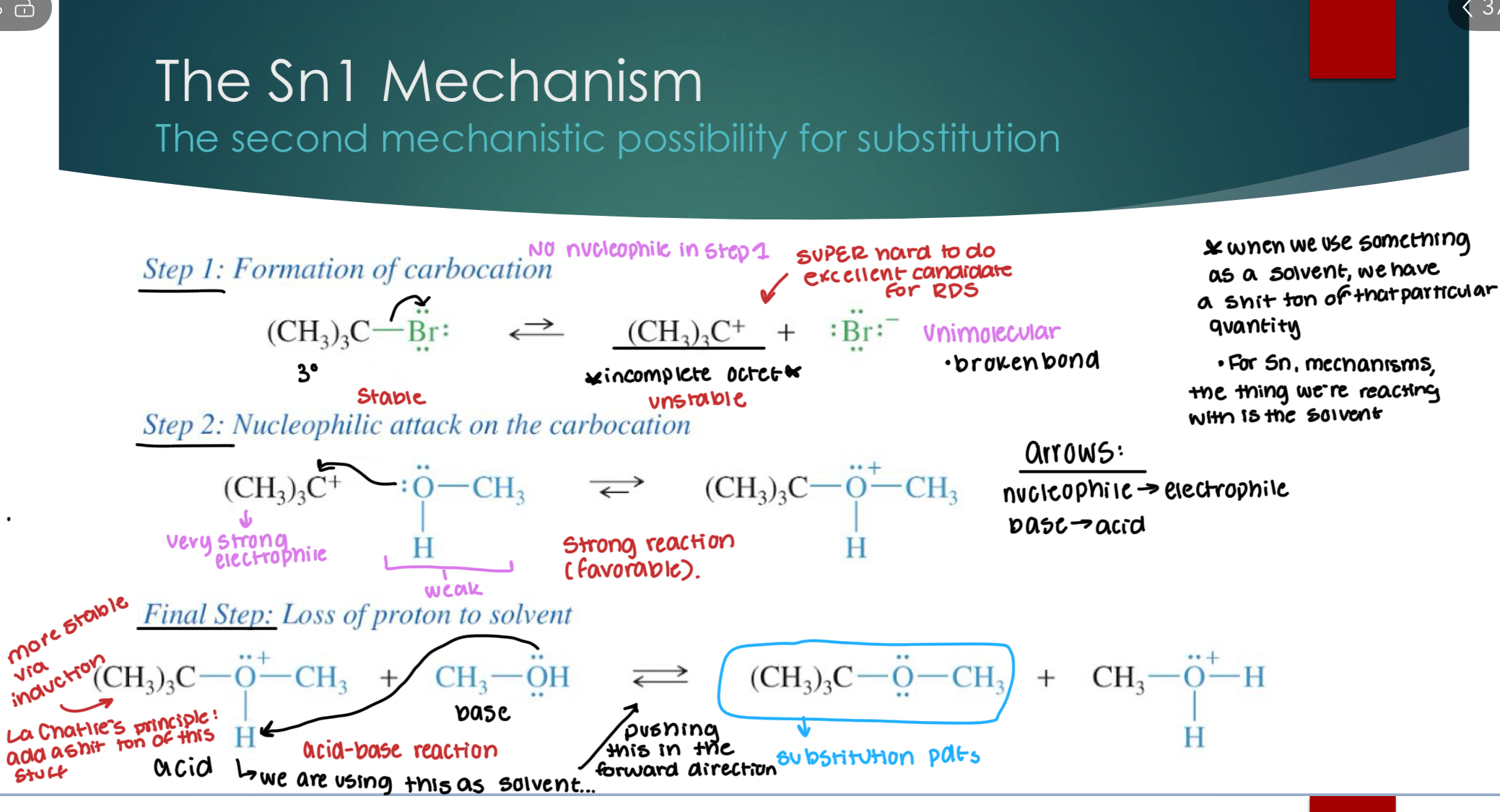
Hammond’s Postulate
It states that the transition state will resemble the structure of its closest to in energy. So, E of the TS is close to the C+, and the E resembles the carbocation energy. Which means, we need to reduce the energy for the carbocation (by making it more stable) to reduce the activation energy for the RDS. In other words, The stability of the carbocation impacts the energy of the transition state so a more stable carbocation intermediate will speed up the Sn1 process.
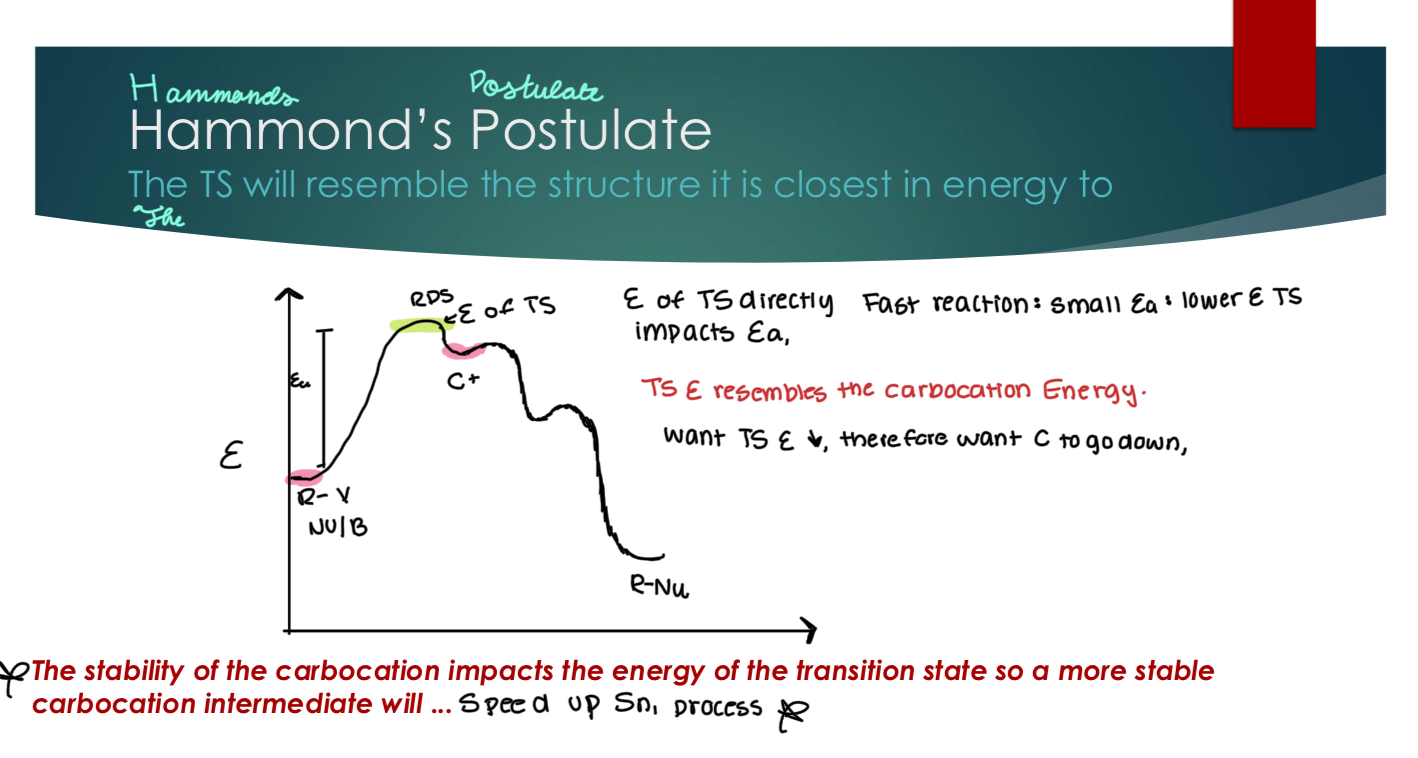
The Carbocation Intermediate
The key aspect of the Sn1 mechanism is the carbocation intermediate!
Carbocations are inherently unstable
Anything that stabilizes the carbocation will make the reaction better (Hammond’s Postulate)
Carbocations will do whatever they can to get more stable: Rearrangements
Carbocation are sp2 so their geometry is: trigonal planar AKA flat!!
Can an sp2 carbon be a stereocenter? NO
The nucleophilic addition to the carbocation controls the stereochemistry of the product(s)
For the stability of the carbocation, we want a tertiary alkyl halide and NOT a primary alkyl halide. (to be a good electrophile).
Nucleophiles in Sn1
Does the nucleophile impact the rate of the Sn1 reaction? Nope! Not in the rate law.
The nucleophile reacts with the carbocation, so does it need to be strong for this step to be favorable? We already have a strong carbocation, so we need a weak nucleophile/base for this to work.
Typical nucleophiles for Sn1 are therefore: solvent quantity (and is possible when it’s weak)
When reacting with solvent: (solvolysis) a synonym for Sn1 type process
Solvent Effects in Sn1
Protic: H-bond donors → stabilize charges via solvation. We want to stablize the carbocation. So we want to use protic solvents!!
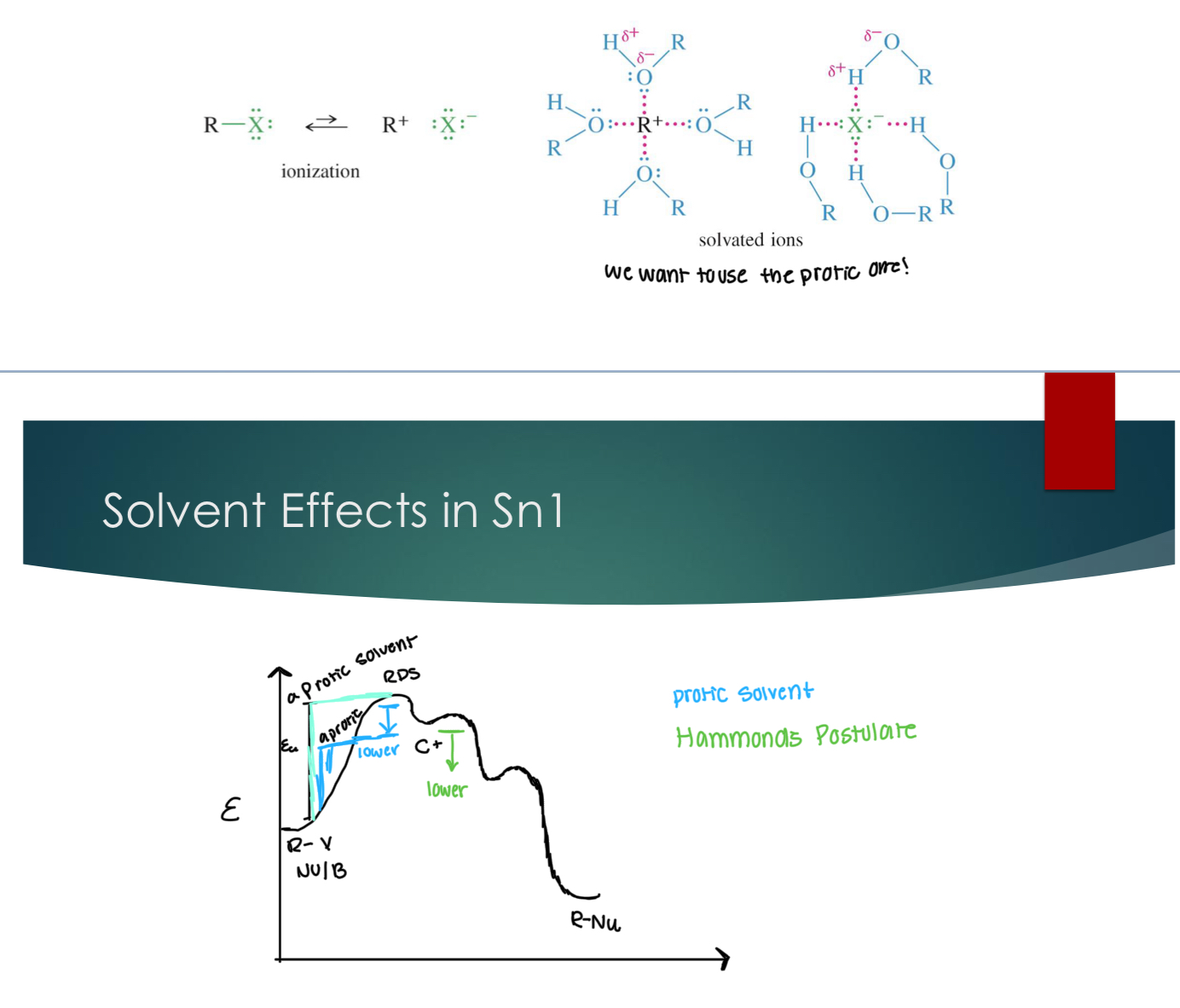
Impacts of having a carbocation intermediate
Carboncation is flat, NOT a stereocenter
So, you get two products when the original molecule has a stereocenter because it doesn’t matter when you approach it from the top or the bottom.
Do NOT memorize that Sn1 gives you enantiomers, it can also give you diastereomers if there are more than one stereocenter.

Sn1 Summary
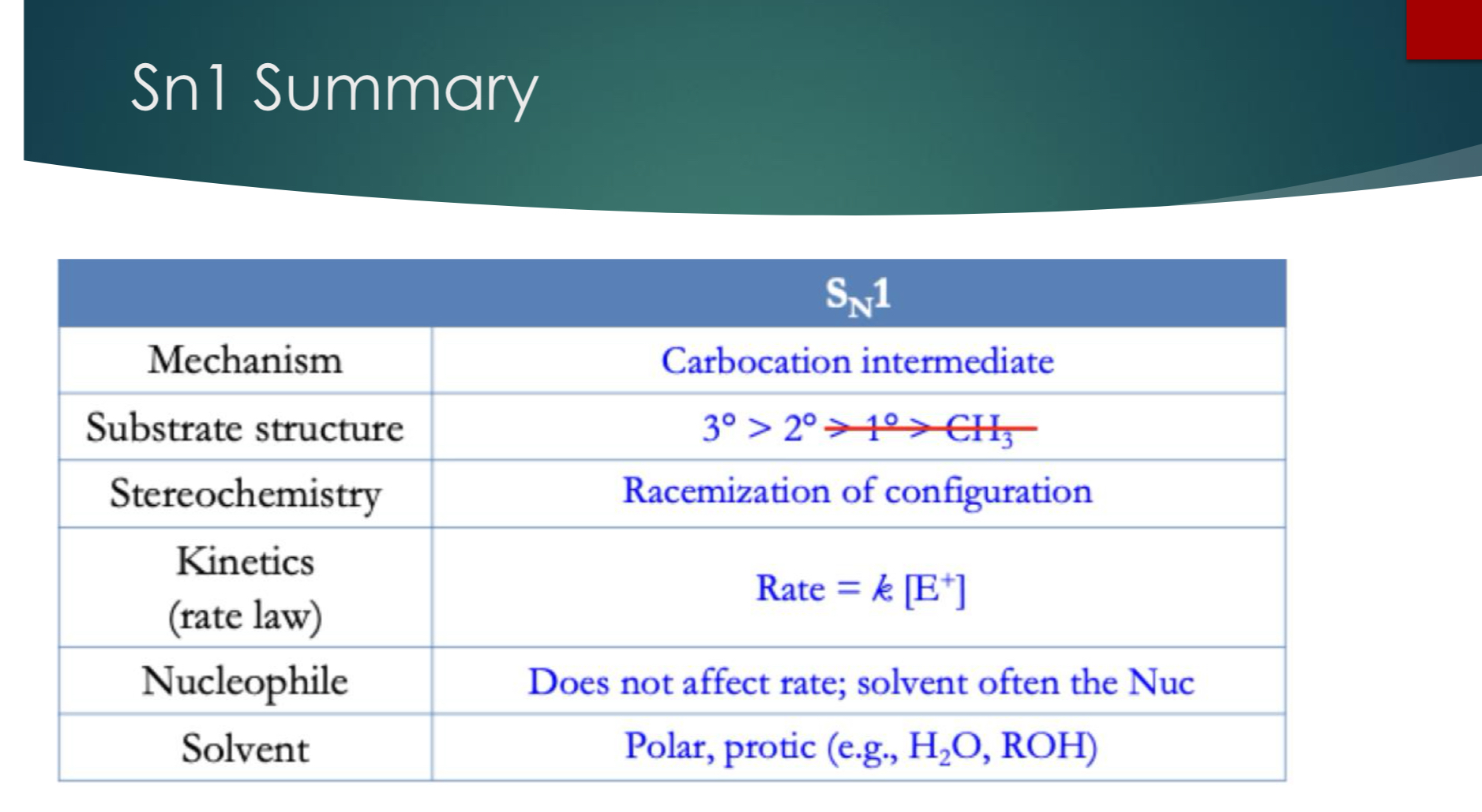
Carbocations are really unstable... If they can easily rearrange to increase stability, they will!
1,2 – Hydride Shift (H w/ two electrons): relation between C+ group and the group that is shifting. Has to be in an ADJACENT position.
1,2 – Methyl Shift: H3C- w/ two electrons in bond.
Carbocation shifts only occur when: it results in a more stable carbocation.
In general, when both types of shifts can produce equally stable carbocations: Hydride is major!
1,2 – Hydride Shift
Things to note:
Carbocations who are already tertiary will not do this
Since primaries are so bad, we can rearrange
Resonance does affect this.
A position next to a benzene ring is called benzylic.
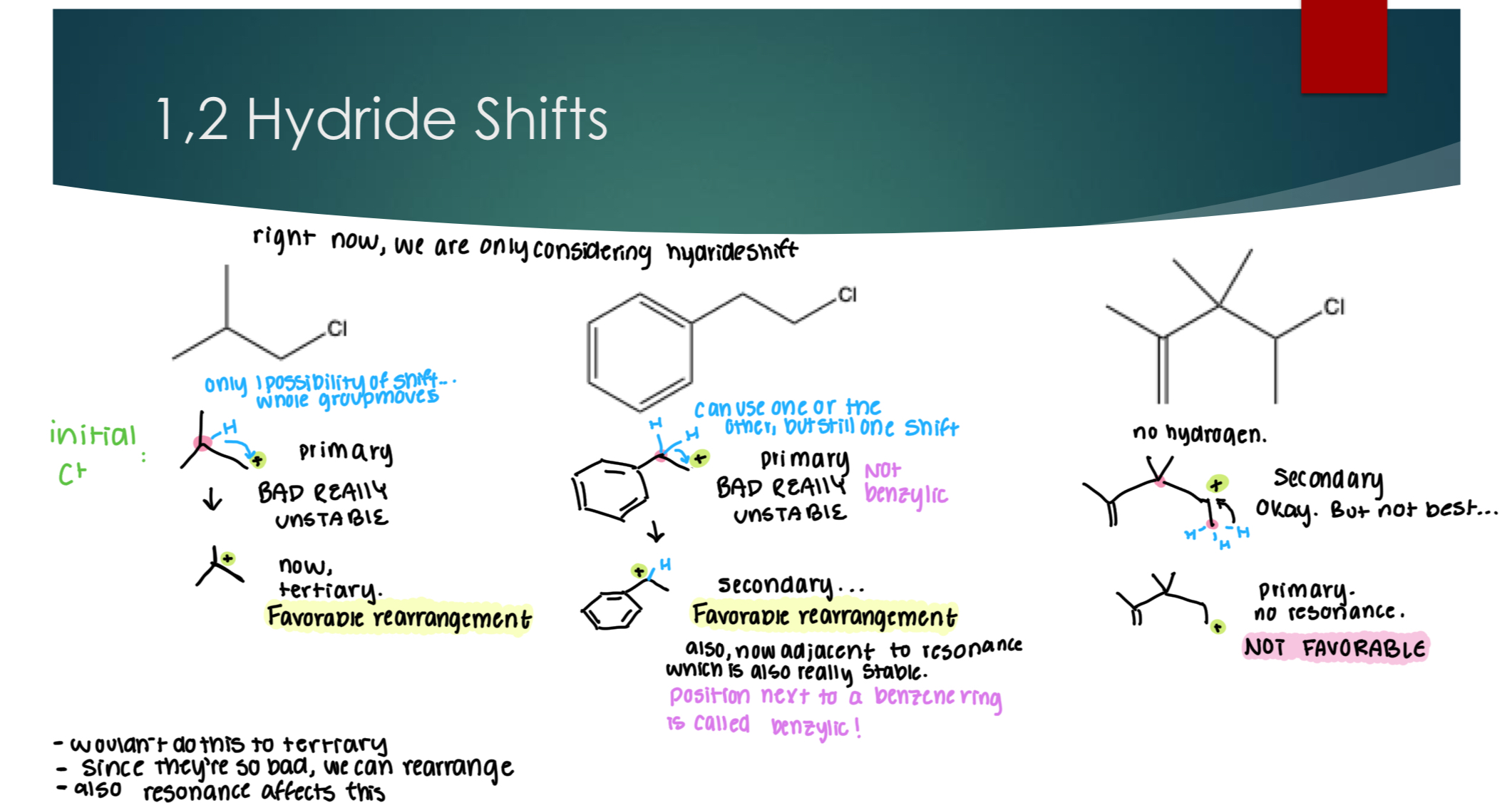
1,2 – Methyl Shift
Evaluating if the methyl shift is better…
Note: if the C+ is next to an alkene, its called allyic. FYI: primary, secondary, and tertiary are called substitution!.
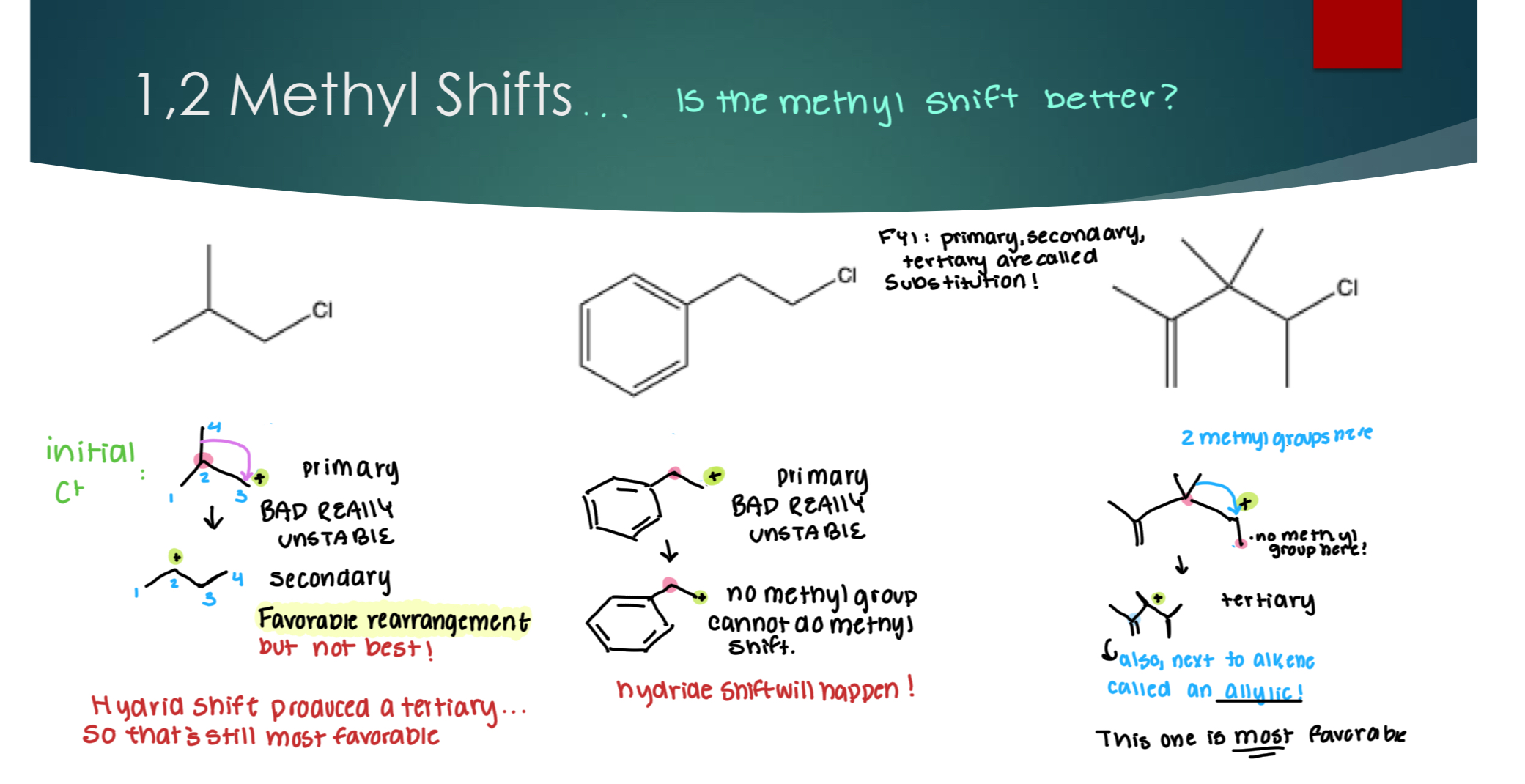
Selectivity Concerns when evaluating rearrangements:
Major is the best organic product, while minor is one of the following conditions:
addition to initial C+
When a rearrangement is favorable, but not the best.
Other Selectivity concerns:
Many nucleophiles can also act as bases and bases attack protons only:
Meaning that you’d want a partial + hydrogen as seen in the example.
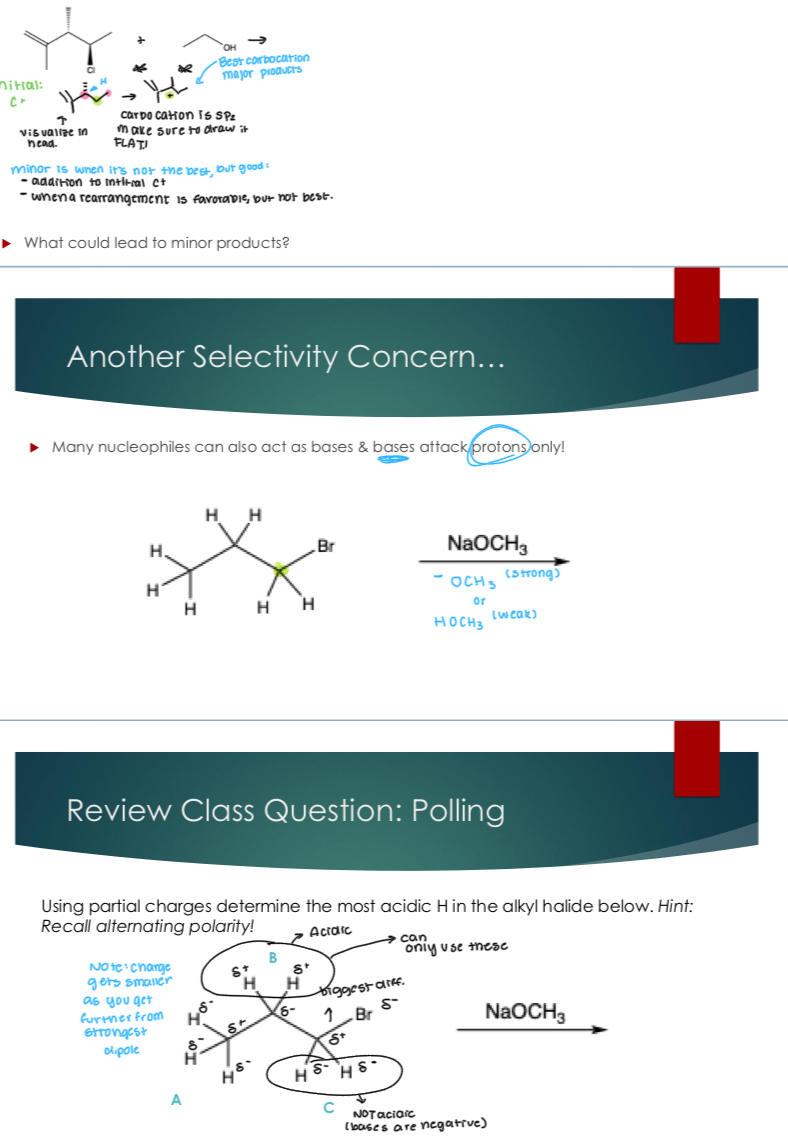
Elimination Reaction introduction
Can occur through multiple mechanisms, and like substitution are named
based on the molecularity of the rate determining step:
E1: unimolecular elimination
E2: bimolecular elimination
Generate alkenes as a product: next functional group focus!